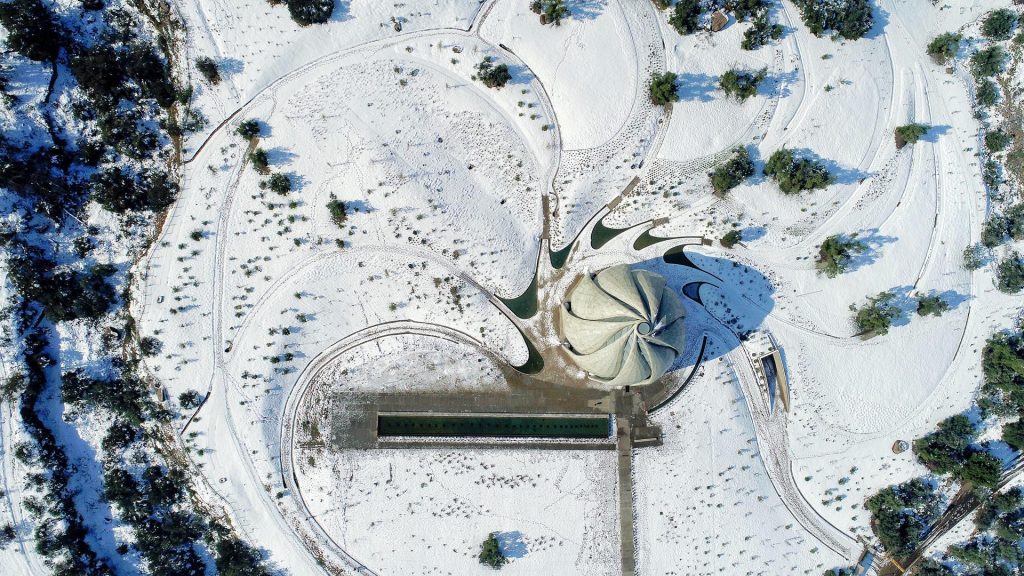The faith Baha’i was founded by Bahá’u’lláh, or the “Glory of God.” The religion originates from Iran in 1844 from the Shi’ite branch of Islam. Like other religions, it possesses its own sacred writings, laws, calendar and holy days. However, rather than a clergy, Baha’i has elected assemblies for administration. The religion focuses on the “oneness of the entire human race,” as well as service to the community and overall universal peace.
Followers of the faith meditate in Baha’i houses of worship around the world. They are also called Mashriqu’l-Adhkárs, or “The Dawning Place of the Mention of God.” Each one features a central dome and nine entrances as well as a garden. The entrances symbolize that people from everywhere come to join at a common ground to simply meditate without mediation from others. It also is a call to the symbol of Baha’i, the nine-pointed star. The number nine represents culmination and comprehensiveness, as it is the largest single digit number. The temples are welcome to everyone, regardless of the religion they follow, to meditate.
Wilmette, Illinois (United States)
Surprisingly, this is the oldest house of faith for Baha’i. It was finished in 1953 by Canadian architect Louis Bourgeois, the construction having spanned both World Wars and the Great Depression. The temple is situated on the shores of Lake Michigan in Illinois, about a half-hour drive from Chicago. The entranceways have white pillars decorated with symbols of the world’s religions, such as the Jewish Star of David and the Christian cross. A beautifully landscaped area surrounds the temple.
New South Wales, Australia
This Baha’i house of worship is located in Ingleside, a suburb of Sydney. It’s also nearby the northern beaches of Sydney. The temple sits on over 20 acres of land, housing a garden full of unique and local plants, as well as a picnic area for guests to enjoy. Groups can receive a guided tour of the temple, complete with refreshments, a walk through the gardens and a video presentation and discussion in the Information Center. Services are held every Sunday at 11 in the morning for about 40 minutes. Readings from the scriptures of major religions and the Baha’i writings are included.
New Delhi, India

Arguably the most famous temple, the Baha’i house of worship in New Delhi has received over 70 million visitors since its inauguration in 1986. It sees over 10,000 people a day on average. Its design is in the shape of a lotus, India’s most sacred flower. There are pools of clear blue-green water that sits by the entrances of the temple, emphasizing the flowery shape. Quick tours are offered to groups larger than 10 where volunteers give guests a brief introduction. Afterward, guests are taken to the Prayer Hall.
Kampala, Uganda
Located on the outskirts of Kampala atop Kikaaya Hill sits Africa’s Baha’i house of worship. It was built in 1961 and is a well-known landmark of the capital of Uganda. The temple was modeled after a traditional African hut. Its dome is covered with white and green mosaic tiles and painted blue on the inside. The divine circle is represented in the dome, which reflects the sacred borders and heaven on earth.
Hesse, Germany
Known for its great acoustics, the German Baha’i temple is made out of steel, aluminum and glass. This Mother Temple of Europe has over 500 windows shaped like diamonds that allow maximum light in. It is located nearby Frankfurt, at the foot of the Taunus mountain range. The designer was Teuto Rocholl, who won the chance after his design was selected in an architectural competition.
Panama City, Panama
Latin America’s first Baha’i temple reminds many guests of an egg, as the building is white and domed. It was built in 1972 by architect Peter Tillotson, siting by itself at the end of a mile-long road from the Transistmica Highway. The temple overlooks Panama City from the top of la montaña de Dulce Canto, “the mountain of beautiful singing.” It has an open layout, allowing for a cool breeze to flow through the building.
Tiapapata, Samoa
Samoa is home to the Mother Temple of the Pacific Islands. It is dedicated by the Malietoa Tanumafili II, one of the kings of Samoa and the first monarch to follow Baha’i. The gardens in Samoa grows over 60 types of flora native to the island and has footpaths and bridges for guests to walk through. A fale, a traditional Samoan architecture, is the inspiration for the shape and design of the dome.
Santiago, Chile
At the foothills of the Andes is South America’s Baha’i house of worship. It was erected in 2016 with the idea of light. With cast glass on the outside and white marble on the inside, the temple allows much light to come in and fill the space. Reflecting pools surrounded the house of worship, as well, increasing the luminosity of the building. The garden was made to flow into the nature surrounding it so it would look as if the garden was endless. In addition, guided visits are offered to groups, offering a look into the architecture of the temple.
Battambang, Cambodia
Asia’s second house of worship is located in Cambodia outside the city of Battambang. Amid rice fields, the temple, its gardens, a meeting hall and administrative building span over 20 acres of land. Drawing from Cambodian-style architecture, the temple was designed by Cambodian architect Tang Sochet Vitou and has a low pointed roof. Brown, yellow, green and white color the temple, offering a dash of color unlike other Baha’i temples. Nine gardens and a fan-shaped pond surround the temple.
Norte del Cauca, Colombia
This is the most recent Baha’i temple erected, having been finished in 2018. The architect Julian Gutierrez Chacón drew inspiration for the building by observing the materials of houses and such in Norte del Cauca, as well as studied local plants. Thus, the roof is made of terracotta tiles with a yellow crown at the the top. This crown represents a blooming cocoa flower and is made of a fluorescent material that naturally lights up with sunsets through sunlight it absorbs during the day.
By Ayumi Davis






